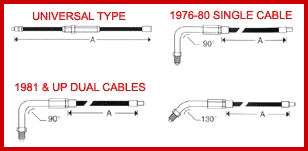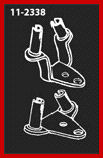One of the more difficult challenges we face in our tech department is the issue of handlebars. Often we hear this simple directive: "I just want to move my hands about two inches farther back." But in order for our tech staff to help you in an efficient manner, we'd really like to have the dimensions of your existing bars. If that information isn't readily available, then it's important that you have an understanding about how things are measured.

First off, you should know that not every motorcycle handlebar manufacturer measures bars the same way. That means that when we see a manufacturer's dimensions on paper, those measurements might be different in person. Manufacturers are reluctant to adopt a uniform measurement system, so we can't always compare apples to apples.
The good news is this: We've created a system that will give fair results - as long as it's done correctly. To measure motorcycle handlebars, I use a table pushed up against a wall. I prop the handlebars in the corner where the table meets the wall, then I rotate the bars forward until the front of the bars touch the wall. In this case, rise is the distance from the table to the highest point on the bars, with pullback measured from the wall to the farthest point back. Here are two other important dimensions: the width of the center section, and on T-bars, how far they rise before they bend back. A T-bar can have the same dimensions yet be very different in appearance. For example, a T-bar that bends two inches from the table will be very different from one that bends five inches from the table, but they can share the same overall dimensions. Other considerations when ordering handlebars
Center Width - Handlebars for Springer Softails are different than bars for other bikes. The reason for this is the riser spacing is different. Common to all Harleys® from 1977 on - except Springers - is a riser center-to-center of 3.5 inches. You Springer guys have a 4-inch riser center-to-center. On narrow glides the 3.5-inch measurement is good back to 1957. Why is this measurement important? Generally, bars have knurls (either a straight line or cross pattern) pressed into them to prevent them from slipping in the risers. If we use a set of standard bars on a Springer, these knurls would be visible and, in my opinion, unsightly.
Dimpled & Drilled - We offer bars in two groupings by year of fitment - pre-1982 and later models. The differences are the result of a change of configuration in the switch housings. The 1972-81 models have a notch in the housings to pass the wires through. The 1982 and newer models don't. Instead, the newer handlebars feature a dimple on the underside to allow room for wires. If you're going to run the wires through the bars you should purchase bars that are drilled for internal wiring.
Tips for Measuring for Comfort
The bottom line for ordering handlebars should be comfort and avoiding fatigue while on the road - unless style trumps comfort when it comes to your motorcycle and you install ape hangers or drag bars. And the easiest way to find yourself a comfortable handlebar is to get some personal measurements.
This involves a friend and some minor tools. Loosen your stock bars in the risers and move them out of the way. Climb on your motorcycle, take it off the kickstand and sit it upright (A friend might be needed to keep the bike balanced). Hold your hands out and simulate driving down the road. Pay close attention to your body position and your wrist position. Once you feel comfortable, have a friend take some measurements, starting with rise, and then working to pullback and overall width. The easiest tool for this measurement is a carpenter's square. All of these measurements are taken from the centerline of the risers straight up (rise), and straight back (pullback). Once you have your measurements, browse our catalog or website to check out our handlebar dimensions.
As always, if you have questions or need assistance picking out handlebars for your motorcycle, don't hesitate to email us a twinmotorcycle@msn.com or call us at 417 832-1534.

Let's start with HD throttle cables. In this modern era we use a two-cable system, something that was mandated by the government to preclude sticking throttles. In case the throttle does stick, the two-cable system has a positive action when the handgrip is closed, closing the throttle.
Through the decades, we've experimented with three types of cables. The first cable was used on "butterfly" type Keihin carbs that were common on Big Twins from 1976 to 89 and XL's from 1976 through 1986. The second cable was used on CV-style Keihin carbs found on Big Twins from 1990 to 1995 and XL's from 1987 to 1995. The third cable type was used from 1996 to 2008 on all models, and from 2009-10, all model except FLT Fly-by-wire systems.
First, a look at the differences: Most cables are measured in outer housing length only. Something to remember is that what's standard for one model bike may be plus-6 for another model. For example, the difference between the butterfly Keihin cables and the CV Keihin cables is the internal wire length. Later style cables have a longer internal wire. On models up to 1996, both cables have a threaded portion that screws into the switch housing. Pull cables (throttle) have different thread diameters than Push (idle) cables, so it's pretty difficult to install them incorrectly. Another identifying feature of an idle cable is a quarter-inch-long spring at the bottom of the cable. Those dating from 1996 and up are no longer threaded and instead use a clip to hold the cable in place. Wire length and different diameters are the same for models 1996 and up.
Who cares, you ask? Why do we even need to know this? A popular modification for bikers these days is to convert to the S&S Carburetor. When this carb was designed, the butterfly Keihin was in use, so the designers at S&S set their carb up to accept the stock cables of the era. This was fine until 1987 on XL's and until 1990 on Big Twins when the carburetor changed. The cables used on the CV were not compatible with the S&S. Because of the way the cables screwed into the switch housing, the easiest solution was to retrofit the stock butterfly Keihin cables to the later model bike. But in 1996, there were no stock cables that could clip in with the proper wire length to use with the S&S. But the aftermarket was quick to jump in with special cables for this application. These special cables worked just fine. Then in 1999, S&S redesigned the cable bracket on the carburetor to allow for the use of the "CV" type cables.

Now there are a ton of carburetors out there that can still work on later model bikes if this updated bracket is installed. The S&S Part Number for this bracket is 400-684. To help identify the two brackets, the earlier unit has relatively flat tubes for the cables while the later bracket has tubes that are raised about an inch.
Once again, the dimension given for clutch cables is the housing length (with the adjuster fully collapsed). What's really great news for the consumer is that on Big Twin models from 1987 through 2003, the clutch cables interchange between models. Once you have determined the length of cable you need, look at the various models and select the length you need. Since 2004, the FLT series bikes and the XL cables use the same design, so cables in these families interchange.
Each manufacturer has different designs on the various models. While Harley cables interchange between models, the metric cables cannot be interchanged. This makes things a bit harder, but you metric riders need not despair. We have some previous posts regarding selecting cable length. You can find that here. Once you have determined the proper length, you can call us and place a special order to get whatever cable length you require. A couple of things you must know about special order cables: Measure carefully! The only way to return a special order cable is if it's defective, so again, please measure carefully. There are no returns if it's the wrong length. The second thing you need to know is that it's going to take four to six weeks for the cable to arrive. That's because these cables are custom made to your dimensions.
That concludes today's post. I hope you have a better understand of how to order cables.
As always, your questions are welcome, twinmotorcycle@msn.com or 417 832-1534.